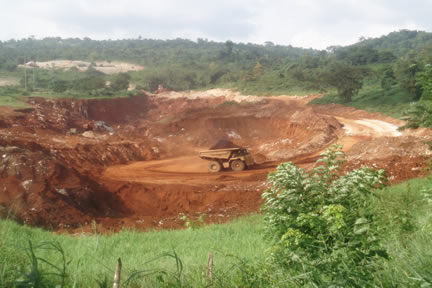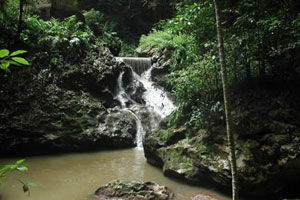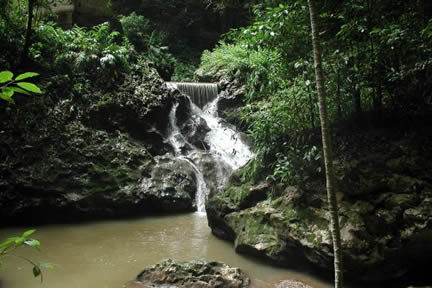Jamaica’s last remaining wilderness, Cockpit Country is a rugged, natural paradise located in the heart of the island. Hundreds of species found nowhere else in the world make their homes in Cockpit Country and its unique geology has created countless caves, waterfalls and towering cliffs throughout the area. The 73,000 Jamaicans in 66 communities living in and around Cockpit Country have created a cultural heritage whose warmth and friendliness is unparalleled. As the location of many of the first Maroon settlements and the battlefield and ally for Maroon fighters in Jamaica’s earliest independence struggles, Cockpit Country is one of the final bastions for the old-time culture of the Jamaican countryside, which is disappearing in today’s modern world. This rich heritage and natural history is kept alive today in the crafts, food, art, music and humanity of Cockpit Country’s residents.
Cockpit Country is a singular place. There is no other place in the world that is even remotely like it. Yet within this internationally recognized wilderness a national debate rages. The only Jamaicans who haven’t heard about this debate in the media in the past weeks are those true bush men and women living too far out in the Cockpit Country wilderness to get any news. It is widely accepted that Cockpit Country has an enormous economic potential that is largely untapped. The debate is how to tap those resources and make them available to the people of Jamaica. Side one of the debate is to exploit Cockpit Country resources through bauxite mining, in which case economic benefits will come until the bauxite runs out and nothing more is left of Cockpit Country. Side two of the debate is to develop a sustainable economic system that builds on this unique natural area and the rich culture and heritage of the people who call it home.
In 1999 and in 2000 a series of Cockpit Country Stakeholder fora funded by the Environmental Foundation of Jamaica (EFJ) were held that brought together a range of stakeholders including community members, farmers, Maroons, government departments, unemployed persons, academics and the Jamaica Bauxite Institute, among others. The general consensus of the stakeholders fora was that Cockpit County was a valuable natural resource for Jamaica and the idea of a project to conserve the biodiversity of Cockpit Country was supported. Ms. Diane Gordon of the Jamaica Bauxite Institute, who attended the stakeholder meetings, stated that “the Jamaica Bauxite Institute supports the effort to protect and conserve Cockpit Country and acknowledges the value of the species that exist there.” She went on to say that exploratory drilling was done on the northern boundary of Cockpit Country in the mid 1990’s and that testing indicated there were bauxite reserves of high economic value. She also made it clear that it would be challenging to mine the area and put in the required management practices necessary to protect Cockpit Country biodiversity.
It is clear from these stakeholder meetings that bauxite mining in Cockpit Country has economic value. It is also clear from statements made at the stakeholders fora that the economic value gained through bauxite mining could not be achieved without serious damage to the natural environment
In the same time period as the Cockpit Country Stakeholder fora a World Bank Cockpit Country conservation survey was executed by NRCA. The survey was conducted within a wide spectrum of Cockpit Country residents and picked up on several potential cutting-edge alternative economic opportunities. Some of the economic opportunities mentioned in the survey were a butterfly ranch and zoo, high-end organic agriculture, hemp product development, spring and mineral water production, essential oils and neutraceuticals, bamboo for housing, agro by-products from yam and other crops, and eco/cultural tourism.
All of these ideas are sustainable, long-term economic projects that provide income AND conserve Cockpit Country. There are organizations that are currently pursuing some of these strategies. We at the Southern Trelawny Environmental Agency are at this moment pursuing an EFJ funded project to work with the Cockpit Country communities of Rock Spring, Alps and Bunkers Hill to develop community and eco-tourism attractions. At the same time we are investigating communities such as Mocho, Oxford, Balaclava and Wilson’s Run for similar opportunities. Under the project seven natural attractions are right now being developed for visitors to come and experience Cockpit Country communities.
These sustainable development strategies can work. The question is where to start. Communities in rural Jamaica do not have millions of dollars at their disposal to pursue projects like bauxite companies do. As a result of the conservation survey conducted six years ago the World Bank wanted to support the development of the entrepreneurial initiatives proposed by the people in Cockpit Country. Had it been pursued, those alternatives would now be generating income to Cockpit Country residents. Why it didn’t happen? The Government of Jamaica would not give assurances to the World Bank that bauxite mining would not take place in Cockpit Country. The World Bank was not prepared to invest in the area as mining would destroy the project’s conservation and economic objectives permanently.
If proper marketing and support is given to Cockpit Country by government and private organizations in Jamaica, the beauty and wonder of Cockpit Country can sustain its residents far into the future. If support is given to bauxite interests little benefit will go to Cockpit Country residents. And when all of the bauxite is take from the forest, nothing will be left to support our future generations. Our children and grandchildren will be denied the opportunities and resources that are rightly theirs.
The debate is raging. Which side of the fence are you on? For more information please visit www.stea.net/bauxite.htm




Bauxite vs the Cockpit Country
Jamaica’s last remaining wilderness, Cockpit Country is a rugged, natural paradise located in the heart of the island. Hundreds of species found nowhere else in the world make their homes in Cockpit Country and its unique geology has created countless caves, waterfalls and towering cliffs throughout the area. The 73,000 Jamaicans in 66 communities living in and around Cockpit Country have created a cultural heritage whose warmth and friendliness is unparalleled. As the location of many of the first Maroon settlements and the battlefield and ally for Maroon fighters in Jamaica’s earliest independence struggles, Cockpit Country is one of the final bastions for the old-time culture of the Jamaican countryside, which is disappearing in today’s modern world. This rich heritage and natural history is kept alive today in the crafts, food, art, music and humanity of Cockpit Country’s residents.
Cockpit Country is a singular place. There is no other place in the world that is even remotely like it. Yet within this internationally recognized wilderness a national debate rages. The only Jamaicans who haven’t heard about this debate in the media in the past weeks are those true bush men and women living too far out in the Cockpit Country wilderness to get any news. It is widely accepted that Cockpit Country has an enormous economic potential that is largely untapped. The debate is how to tap those resources and make them available to the people of Jamaica. Side one of the debate is to exploit Cockpit Country resources through bauxite mining, in which case economic benefits will come until the bauxite runs out and nothing more is left of Cockpit Country. Side two of the debate is to develop a sustainable economic system that builds on this unique natural area and the rich culture and heritage of the people who call it home.
In 1999 and in 2000 a series of Cockpit Country Stakeholder fora funded by the Environmental Foundation of Jamaica (EFJ) were held that brought together a range of stakeholders including community members, farmers, Maroons, government departments, unemployed persons, academics and the Jamaica Bauxite Institute, among others. The general consensus of the stakeholders fora was that Cockpit County was a valuable natural resource for Jamaica and the idea of a project to conserve the biodiversity of Cockpit Country was supported. Ms. Diane Gordon of the Jamaica Bauxite Institute, who attended the stakeholder meetings, stated that “the Jamaica Bauxite Institute supports the effort to protect and conserve Cockpit Country and acknowledges the value of the species that exist there.” She went on to say that exploratory drilling was done on the northern boundary of Cockpit Country in the mid 1990’s and that testing indicated there were bauxite reserves of high economic value. She also made it clear that it would be challenging to mine the area and put in the required management practices necessary to protect Cockpit Country biodiversity.
It is clear from these stakeholder meetings that bauxite mining in Cockpit Country has economic value. It is also clear from statements made at the stakeholders fora that the economic value gained through bauxite mining could not be achieved without serious damage to the natural environment
In the same time period as the Cockpit Country Stakeholder fora a World Bank Cockpit Country conservation survey was executed by NRCA. The survey was conducted within a wide spectrum of Cockpit Country residents and picked up on several potential cutting-edge alternative economic opportunities. Some of the economic opportunities mentioned in the survey were a butterfly ranch and zoo, high-end organic agriculture, hemp product development, spring and mineral water production, essential oils and neutraceuticals, bamboo for housing, agro by-products from yam and other crops, and eco/cultural tourism.
All of these ideas are sustainable, long-term economic projects that provide income AND conserve Cockpit Country. There are organizations that are currently pursuing some of these strategies. We at the Southern Trelawny Environmental Agency are at this moment pursuing an EFJ funded project to work with the Cockpit Country communities of Rock Spring, Alps and Bunkers Hill to develop community and eco-tourism attractions. At the same time we are investigating communities such as Mocho, Oxford, Balaclava and Wilson’s Run for similar opportunities. Under the project seven natural attractions are right now being developed for visitors to come and experience Cockpit Country communities.
These sustainable development strategies can work. The question is where to start. Communities in rural Jamaica do not have millions of dollars at their disposal to pursue projects like bauxite companies do. As a result of the conservation survey conducted six years ago the World Bank wanted to support the development of the entrepreneurial initiatives proposed by the people in Cockpit Country. Had it been pursued, those alternatives would now be generating income to Cockpit Country residents. Why it didn’t happen? The Government of Jamaica would not give assurances to the World Bank that bauxite mining would not take place in Cockpit Country. The World Bank was not prepared to invest in the area as mining would destroy the project’s conservation and economic objectives permanently.
If proper marketing and support is given to Cockpit Country by government and private organizations in Jamaica, the beauty and wonder of Cockpit Country can sustain its residents far into the future. If support is given to bauxite interests little benefit will go to Cockpit Country residents. And when all of the bauxite is take from the forest, nothing will be left to support our future generations. Our children and grandchildren will be denied the opportunities and resources that are rightly theirs.
The debate is raging. Which side of the fence are you on? For more information please visit www.stea.net/bauxite.htm
More Stories
The Story of Seaford Town: An Unlikely German Village in Rural Jamaica
Clemson to Induct Jamaican Track Star Natoya Goule-Toppin into 2025 Hall of Fame
WEEKLY DEVOTIONAL: Growing in Grace
Bringing Jamaica to Washington: Seattle’s First Caribbean Market and Kitchen Turns 6
The History of Jamaica’s Parishes: From Spanish Rule to British Administration